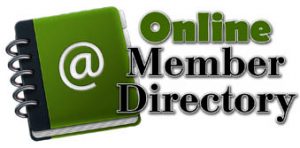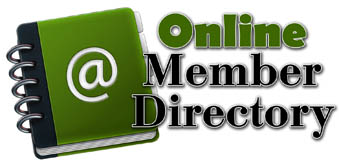How to Create a Membership Directory on Your Website
 The membership directory described below was created for a small organization, so that members could share contact information. Here were some of the concerns and methods.
The membership directory described below was created for a small organization, so that members could share contact information. Here were some of the concerns and methods.
Directory Access
First, the directory must be visible to members only. This can be achieved either with a password-protected page, or a page that is visible only to logged-in WordPress Users. The advantage of a password-protected page is that logging into the site is not required to see the directory, and a single password can be shared among the group; however, if the password is changed, the group must be notified via email. Restricting visibility to WordPress users is more secure, but requires the user to login (and of course remember their username and password). Here are details:
Password protection is set up using the default WordPress option in the Publish field of a page (visibility set to password protected). Plugins for added functionality include the Custom Password Protected Text plugin (to add custom text for those not logged in), and the Protected Posts Logout Button, which allows users to logout of the page if they are on a public computer. A system must be in place to email users; I use the Newsletter plugin, which can also be used to capture user information.
WordPress User visibility can be achieved via plugins, for example the Restrict Access plugin. On my sites that use Weaver theme, I use a Weaver shortcode, which has options for alternate text for persons who are and who are not logged in.
How do you collect member information and display the directory? I have developed two options:
Collecting Member Information and Displaying the Directory
Option (1) uses the WP user registration functionality to collect member information combined with the AMR Users plugin to show the directory, and option (2) uses the Newsletter plugin to collect subscriber (member) info and the TablePress plugin to show the directory. In both cases, the Newsletter plugin is used to send news to the group.
The WP User/AMR method has the advantage that the directory updates in real time (or nearly so), and a user can delete themselves from the directory automatically by deleting their WordPress user account. In the Newlsetter/TablePress approach, a database is maintained on the site (and can be accessed by the user), but the user has no account on the site; this may be easier from the user side – but, the directory listing must be updated manually.
OPTION 1 – WP User Registration and the AMR Users
User Registration is a standard WordPress functionality; in the Settings > General menu, membership must be set to “Anyone can register”. I used the Cimy User Extra Fields plugin to add custom fields (and a captcha form) to the registration. If desired, a custom welcome email can be sent using, e.g., the SB Custom Welcome Email plugin.
Members should be manually screened during the registration process, for example using the New User Approve plugin, Alternatively, if the directory is on a password-protected page, the member can be screened after registration, by sending a custom email that includes the member directory password. In either case, screening is a manual step. If sending an email to users, consider the Email Users plugin.
The directory can be listed on the site using the AMR Users plugin, which allows real-time updates and listing of users. The extra fields were pulled into the AMR Users database with the premium addon AMR-Users-Plus-Climy (available for $8). The page admin can be alerted to any changes in a User’s fields, which could be handy (the cache can be rebuilt at a specified interval to update the list).
A newsletter subscription can also be added to the WP User registration form, for example using the Newsletter plugin. This way, emails can be sent to the member list (and members can subscribe/unsubscribe from the newsletters).
Users can remove themselves from the WP User database using the Delete Me plugin, which shows a ‘delete me’ option at the bottom of the profile, and they can unsubscribe to the newsletter using the unsubscribe link in emails.
OPTION 2 – Newsletter Plugin
Member information can also be collected using the Newsletter plugin, with any desired fields added.
Display of the member information is only possible, however, by downloading and uploading the subscriber database. This can be setup in two steps. First the subscriber database is saved as a CSV file.
Display the list using the TablePress plugin, which allows an import to replace an existing table. If necessary, create a custom table header from the fields of a first dummy subscriber.
Members are screened because the list must be updated manually; the admin is notified of new subscribers, at which point they can either accept the new subscription, or remove the subscriber from the database.
Members can update their subscriber preferences via a link in the welcome email (or newsletter subscription links); however, the updates are invisible to the site admin, who will therefore not know if an update to the directory is required. Also, subscribers cannot delete themselves from the database (or the directory list), and they therefore must contact the site admin to do so.





Leave a Reply
Want to join the discussion?Feel free to contribute!